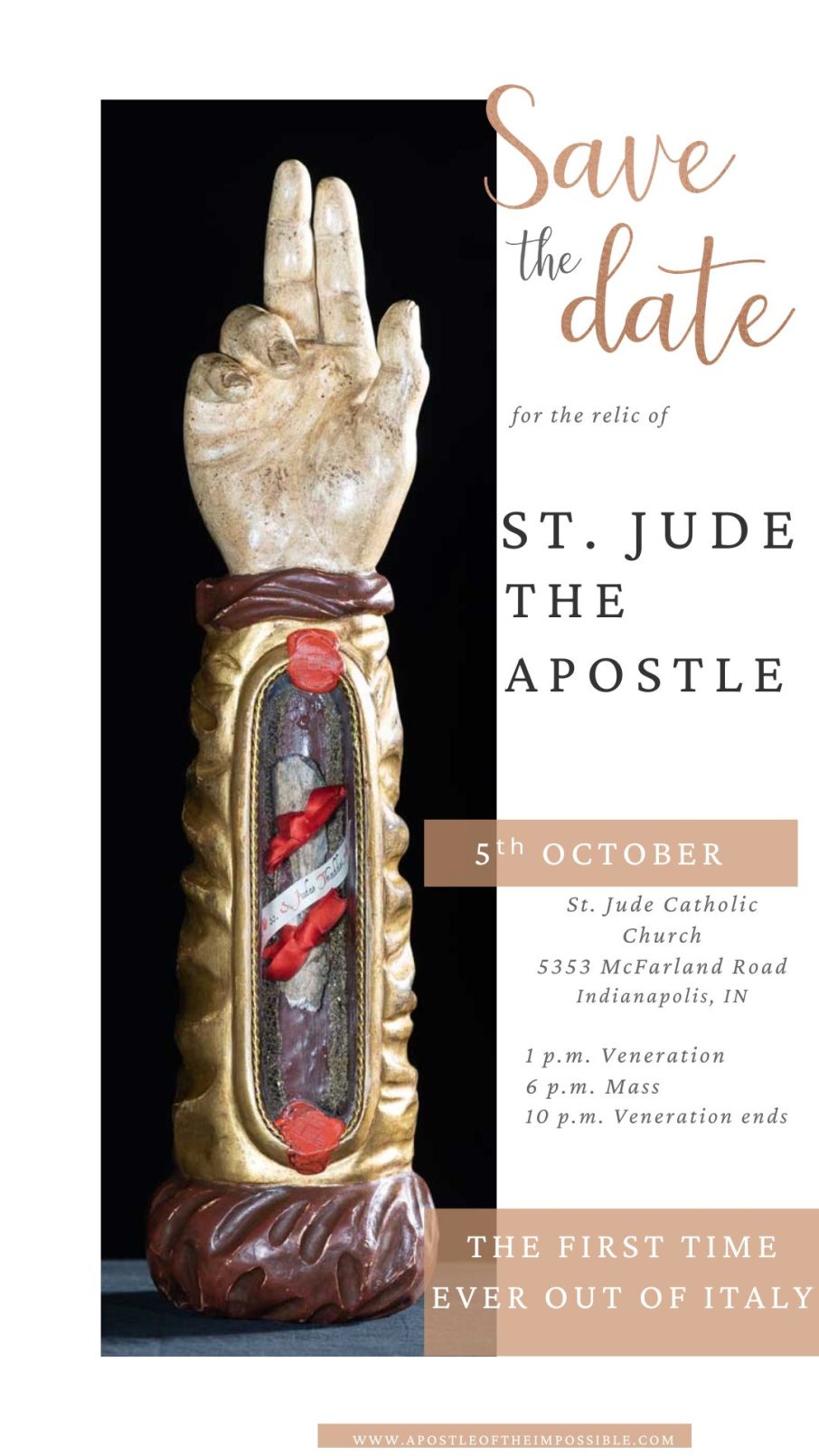For the first time the relic of St. Jude the Apostle’s arm is leaving Italy for Indianapolis!
The Apostle of the Impossible is the patron saint of despairing causes where there is no hope or no known way out of a situation.
Devotees of St. Jude affirm the saint’s deep intercession, making him one of the Catholic Church’s’ most popular saints for those who are in desperate situations.
When things seem lost or unbearable—when they seem hopeless—Saint Jude is the one to whom people often turn.
Come and experience his transformative presence. Come and see what he has for you. -Apostle of the Impossible website
Who is St. Jude
Saint Jude was part of a group of twelve men called Apostles, a Greek term meaning “one who is sent.”
The New Testament refers to Jude as “the brother of Jesus” in two passages (Matthew 13:55, Mark 6:3). However, this does not mean that Jude was the Lord’s blood brother. The Greek word for brother can also mean “cousin,” “family member,” or even just “acquaintance,” the Apostle of the Impossible website explained.
The Church Father, Papias of Hierapolis (c. 70–163 AD), informs us within his work, Exposition of the Sayings of the Lord, that Jude is the son of Mary of Cleophas, one of the women at the foot of the Cross during Our Lord’s crucifixion (John 19:25). But Papias also states that Mary of Cleophas was the sister of Mary, the mother of the Lord, making Jude the Lord’s cousin.
What is a relic?
Relics are physical objects that have a direct association with the saints or with Our Lord.
There are three classes of relics:
- First-class relics are the body or fragments of the body of a saint, such as pieces of bone or flesh.
- Second-class relics are something that a saint personally owned, such as a shirt or book (or fragments of those items).
- Third-class relics are those items that a saint touched or that have been touched by a first, second, or another third-class relic of a saint. About third class relics, the touch does not have to be a direct touch to the relic itself. Merely touching the container that houses the relic is sufficient to bring about that transformation and effect of a new relic.
Are Relics Mentioned in Scripture?
Scripture teaches that God acts through relics, especially in terms of healing.
The Bible states:
- When the corpse of a man was touched to the bones of the prophet Elisha the man came back to life and rose to his feet (2 Kings 13:20-21).
- A woman was healed of her hemorrhage simply by touching the hem of Jesus’ cloak (Matthew 9:20-22), and Mark informs us that as many as touched it were healed (Mark 6:56).
- The signs and wonders worked by the Apostles were so great that people would line the streets with the sick so that when Peter walked by at least his shadow might ‘touch’ them (Acts 5:12-15). Even Peter’s shadow was healing.
- When handkerchiefs or aprons that had been touched to Paul were applied to the sick, the people were healed and evil spirits were driven out of them (Acts 19:11-12).
What is the Arm of St. Jude?
St. Jude’s arm was separated from the greater portion of his remains several centuries ago It was placed in a simple wooden reliquary carved in the shape of an upright arm in the gesture of imparting a blessing.
This arm surely touched Christ, in a handshake, patting the Lord on the back, or embracing him in a brotherly hug. It’s coming so close to us is a grace not to be missed.
What Happened to St. Jude?
Some records indicate he preached in Mesopotamia, including present-day Iraq and parts of present-day Iran, Kuwait, Syria, and Turkey. It was there that he partnered with Simon the Zealot.
We know the two Apostles returned to Jerusalem in approximately 50 AD for the Council of Jerusalem.
According to the fourth-century ancient Christian historian Eusebius of Caesarea, Jude again returned to Jerusalem in the year 62 and assisted in the election of his brother, Saint Simeon, as the second Bishop of Jerusalem (following the martyrdom of his other brother, James the Less).
Ancient records state St. Jude’s martyrdom and burial was in Beirut. Later, his body was transferred to Rome and placed in a crypt in St. Peter’s Basilica. His remains rest below the main altar of St. Joseph within a tomb also holding the remains of St. Peter the Apostle.
The Words of St. Jude
St. Jude’s Epistle ends with some of the most moving words in Scripture about the glory of Christ:
“To the only God our Saviour through Jesus Christ our Lord, be glory and magnificence, empire and power, before all ages, and now, and for all ages of ages. Amen.”
It is clear St. Jude’s strong faith came through the glory of God’s magnificence. It is where we too can draw our strength, hope, and love.
Pray With Us the Novena of St. Jude
In honor of St. Jude’s relic coming to our Archdiocese, Fr. Jerry Byrd is asking all parishioners to pray a nine-day novena to the saint.
Most holy Apostle, St. Jude, faithful servant and friend of Jesus, the Church honors and invokes you universally, as the patron of difficult cases, of things almost despaired of, pray for me, I am so helpless and alone.
Intercede with God for me that He bring visible and speedy help where help is almost despaired of. Come to my assistance in this great need that I may receive the consolation and help of heaven in all my necessities, tribulations, and sufferings, particularly –
(make your request here)
– and that I may praise God with you and all the saints forever. I promise, O Blessed St. Jude, to be ever mindful of this great favor granted me by God and to always honor you as my special and powerful patron, and to gratefully encourage devotion to you. Amen.



